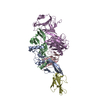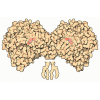[English] 日本語
 Yorodumi
Yorodumi- PDB-9fdy: Betaglycan Orphan Domain (ratBGo) in complex with TGF-b1 and extr... -
+ Open data
Open data
- Basic information
Basic information
| Entry | Database: PDB / ID: 9fdy | |||||||||||||||
|---|---|---|---|---|---|---|---|---|---|---|---|---|---|---|---|---|
| Title | Betaglycan Orphan Domain (ratBGo) in complex with TGF-b1 and extracellular domain of TGFBRII | |||||||||||||||
 Components Components |
| |||||||||||||||
 Keywords Keywords | MEMBRANE PROTEIN / Complex / Betaglycan / TGFBR3 / TGFb1 / TGFBR2 | |||||||||||||||
| Function / homology |  Function and homology information Function and homology informationTGFBR3 PTM regulation / TGFBR3 regulates FGF2 signaling / negative regulation of apoptotic process involved in morphogenesis / TGFBR3 regulates activin signaling / response to luteinizing hormone / transforming growth factor beta receptor activity, type III / FGFR1b ligand binding and activation / FGFR1c ligand binding and activation / transforming growth factor beta receptor complex assembly / epicardium-derived cardiac fibroblast cell development ...TGFBR3 PTM regulation / TGFBR3 regulates FGF2 signaling / negative regulation of apoptotic process involved in morphogenesis / TGFBR3 regulates activin signaling / response to luteinizing hormone / transforming growth factor beta receptor activity, type III / FGFR1b ligand binding and activation / FGFR1c ligand binding and activation / transforming growth factor beta receptor complex assembly / epicardium-derived cardiac fibroblast cell development / Signaling by BMP / TGF-beta receptor signaling activates SMADs / inhibin-betaglycan-ActRII complex / response to follicle-stimulating hormone / positive regulation of tolerance induction to self antigen / positive regulation of B cell tolerance induction / muscular septum morphogenesis / inferior endocardial cushion morphogenesis / definitive erythrocyte differentiation / transforming growth factor beta receptor activity, type II / bronchus morphogenesis / cellular response to acetaldehyde / frontal suture morphogenesis / mammary gland morphogenesis / Influenza Virus Induced Apoptosis / adaptive immune response based on somatic recombination of immune receptors built from immunoglobulin superfamily domains / positive regulation of microglia differentiation / regulation of interleukin-23 production / branch elongation involved in mammary gland duct branching / positive regulation of primary miRNA processing / lens fiber cell apoptotic process / TGFBR3 regulates TGF-beta signaling / columnar/cuboidal epithelial cell maturation / growth plate cartilage chondrocyte growth / negative regulation of skeletal muscle tissue development / macrophage derived foam cell differentiation / response to laminar fluid shear stress / embryonic liver development / tricuspid valve morphogenesis / regulation of enamel mineralization / regulation of branching involved in mammary gland duct morphogenesis / regulation of cartilage development / TGFBR2 MSI Frameshift Mutants in Cancer / regulation of striated muscle tissue development / miRNA transport / regulation of blood vessel remodeling / regulation of protein import into nucleus / regulatory T cell differentiation / tolerance induction to self antigen / BMP binding / transforming growth factor beta ligand-receptor complex / extracellular matrix assembly / vasculogenesis involved in coronary vascular morphogenesis / negative regulation of natural killer cell mediated cytotoxicity directed against tumor cell target / negative regulation of hyaluronan biosynthetic process / type III transforming growth factor beta receptor binding / aorta morphogenesis / myofibroblast differentiation / positive regulation of epithelial to mesenchymal transition involved in endocardial cushion formation / positive regulation of cardiac muscle cell differentiation / positive regulation of odontogenesis / Signaling by Activin / connective tissue replacement involved in inflammatory response wound healing / Langerhans cell differentiation / apoptotic process involved in morphogenesis / TGFBR2 Kinase Domain Mutants in Cancer / transforming growth factor beta receptor activity / positive regulation of smooth muscle cell differentiation / positive regulation of exit from mitosis / cardiac left ventricle morphogenesis / regulation of transforming growth factor beta receptor signaling pathway / secondary palate development / negative regulation of macrophage cytokine production / odontoblast differentiation / SMAD2/3 Phosphorylation Motif Mutants in Cancer / TGFBR1 KD Mutants in Cancer / negative regulation of epithelial cell migration / positive regulation of isotype switching to IgA isotypes / positive regulation of mesenchymal stem cell proliferation / positive regulation of receptor signaling pathway via STAT / endocardial cushion fusion / ventricular compact myocardium morphogenesis / membrane protein intracellular domain proteolysis / positive regulation of extracellular matrix assembly / retina vasculature development in camera-type eye / membranous septum morphogenesis / positive regulation of T cell tolerance induction / heart valve morphogenesis / bronchiole development / positive regulation of NK T cell differentiation / mammary gland branching involved in thelarche / hyaluronan catabolic process / cardiac epithelial to mesenchymal transition / TGFBR3 regulates TGF-beta signaling / positive regulation of vasculature development / lens fiber cell differentiation / activin receptor complex / activin receptor activity, type I / collagen metabolic process / lung lobe morphogenesis Similarity search - Function | |||||||||||||||
| Biological species |  Homo sapiens (human) Homo sapiens (human) | |||||||||||||||
| Method | ELECTRON MICROSCOPY / single particle reconstruction / cryo EM / Resolution: 3.4 Å | |||||||||||||||
 Authors Authors | Wieteska, L. / Cherepanov, P. / Punch, E. / Hinck, A.P. / Hill, C.S. | |||||||||||||||
| Funding support | European Union,  United Kingdom, United Kingdom,  United States, 4items United States, 4items
| |||||||||||||||
 Citation Citation |  Journal: Nat Commun / Year: 2025 Journal: Nat Commun / Year: 2025Title: Structures of TGF-β with betaglycan and signaling receptors reveal mechanisms of complex assembly and signaling. Authors: Łukasz Wieteska / Alexander B Taylor / Emma Punch / Jonathan A Coleman / Isabella O Conway / Yeu-Farn Lin / Chang-Hyeock Byeon / Cynthia S Hinck / Troy Krzysiak / Rieko Ishima / Fernando ...Authors: Łukasz Wieteska / Alexander B Taylor / Emma Punch / Jonathan A Coleman / Isabella O Conway / Yeu-Farn Lin / Chang-Hyeock Byeon / Cynthia S Hinck / Troy Krzysiak / Rieko Ishima / Fernando López-Casillas / Peter Cherepanov / Daniel J Bernard / Caroline S Hill / Andrew P Hinck /     Abstract: Betaglycan (BG) is a transmembrane co-receptor of the transforming growth factor-β (TGF-β) family of signaling ligands. It is essential for embryonic development, tissue homeostasis and fertility ...Betaglycan (BG) is a transmembrane co-receptor of the transforming growth factor-β (TGF-β) family of signaling ligands. It is essential for embryonic development, tissue homeostasis and fertility in adults. It functions by enabling binding of the three TGF-β isoforms to their signaling receptors and is additionally required for inhibin A (InhA) activity. Despite its requirement for the functions of TGF-βs and InhA in vivo, structural information explaining BG ligand selectivity and its mechanism of action is lacking. Here, we determine the structure of TGF-β bound both to BG and the signaling receptors, TGFBR1 and TGFBR2. We identify key regions responsible for ligand engagement, which has revealed binding interfaces that differ from those described for the closely related co-receptor of the TGF-β family, endoglin, thus demonstrating remarkable evolutionary adaptation to enable ligand selectivity. Finally, we provide a structural explanation for the hand-off mechanism underlying TGF-β signal potentiation. | |||||||||||||||
| History |
|
- Structure visualization
Structure visualization
| Structure viewer | Molecule:  Molmil Molmil Jmol/JSmol Jmol/JSmol |
|---|
- Downloads & links
Downloads & links
- Download
Download
| PDBx/mmCIF format |  9fdy.cif.gz 9fdy.cif.gz | 157.2 KB | Display |  PDBx/mmCIF format PDBx/mmCIF format |
|---|---|---|---|---|
| PDB format |  pdb9fdy.ent.gz pdb9fdy.ent.gz | 123.8 KB | Display |  PDB format PDB format |
| PDBx/mmJSON format |  9fdy.json.gz 9fdy.json.gz | Tree view |  PDBx/mmJSON format PDBx/mmJSON format | |
| Others |  Other downloads Other downloads |
-Validation report
| Summary document |  9fdy_validation.pdf.gz 9fdy_validation.pdf.gz | 1.1 MB | Display |  wwPDB validaton report wwPDB validaton report |
|---|---|---|---|---|
| Full document |  9fdy_full_validation.pdf.gz 9fdy_full_validation.pdf.gz | 1.1 MB | Display | |
| Data in XML |  9fdy_validation.xml.gz 9fdy_validation.xml.gz | 37.9 KB | Display | |
| Data in CIF |  9fdy_validation.cif.gz 9fdy_validation.cif.gz | 54.9 KB | Display | |
| Arichive directory |  https://data.pdbj.org/pub/pdb/validation_reports/fd/9fdy https://data.pdbj.org/pub/pdb/validation_reports/fd/9fdy ftp://data.pdbj.org/pub/pdb/validation_reports/fd/9fdy ftp://data.pdbj.org/pub/pdb/validation_reports/fd/9fdy | HTTPS FTP |
-Related structure data
| Related structure data |  50333MC  8dc0C  9b9fC  9fk5C  9fkpC M: map data used to model this data C: citing same article ( |
|---|---|
| Similar structure data | Similarity search - Function & homology  F&H Search F&H Search |
- Links
Links
- Assembly
Assembly
| Deposited unit | 
|
|---|---|
| 1 |
|
- Components
Components
| #1: Protein | Mass: 12809.812 Da / Num. of mol.: 2 / Fragment: Mature Source method: isolated from a genetically manipulated source Source: (gene. exp.)  Homo sapiens (human) / Gene: TGFB1, TGFB / Production host: Homo sapiens (human) / Gene: TGFB1, TGFB / Production host:  #2: Protein | | Mass: 38109.473 Da / Num. of mol.: 1 Source method: isolated from a genetically manipulated source Source: (gene. exp.)   Homo sapiens (human) / References: UniProt: P26342 Homo sapiens (human) / References: UniProt: P26342#3: Protein | Mass: 12926.812 Da / Num. of mol.: 2 Source method: isolated from a genetically manipulated source Source: (gene. exp.)  Homo sapiens (human) / Gene: TGFBR2 / Production host: Homo sapiens (human) / Gene: TGFBR2 / Production host:  References: UniProt: P37173, receptor protein serine/threonine kinase Has protein modification | Y | |
|---|
-Experimental details
-Experiment
| Experiment | Method: ELECTRON MICROSCOPY |
|---|---|
| EM experiment | Aggregation state: PARTICLE / 3D reconstruction method: single particle reconstruction |
- Sample preparation
Sample preparation
| Component |
| ||||||||||||||||||||||||||||||
|---|---|---|---|---|---|---|---|---|---|---|---|---|---|---|---|---|---|---|---|---|---|---|---|---|---|---|---|---|---|---|---|
| Molecular weight |
| ||||||||||||||||||||||||||||||
| Source (natural) |
| ||||||||||||||||||||||||||||||
| Source (recombinant) |
| ||||||||||||||||||||||||||||||
| Buffer solution | pH: 7.4 | ||||||||||||||||||||||||||||||
| Buffer component |
| ||||||||||||||||||||||||||||||
| Specimen | Conc.: 0.6 mg/ml / Embedding applied: NO / Shadowing applied: NO / Staining applied: NO / Vitrification applied: YES | ||||||||||||||||||||||||||||||
| Specimen support | Grid material: GOLD / Grid type: UltrAuFoil R1.2/1.3 | ||||||||||||||||||||||||||||||
| Vitrification | Instrument: FEI VITROBOT MARK IV / Cryogen name: ETHANE / Humidity: 100 % / Chamber temperature: 277 K |
- Electron microscopy imaging
Electron microscopy imaging
| Experimental equipment |  Model: Titan Krios / Image courtesy: FEI Company |
|---|---|
| Microscopy | Model: FEI TITAN KRIOS |
| Electron gun | Electron source:  FIELD EMISSION GUN / Accelerating voltage: 300 kV / Illumination mode: FLOOD BEAM FIELD EMISSION GUN / Accelerating voltage: 300 kV / Illumination mode: FLOOD BEAM |
| Electron lens | Mode: BRIGHT FIELD / Nominal defocus max: 3500 nm / Nominal defocus min: 1500 nm |
| Image recording | Electron dose: 50 e/Å2 / Film or detector model: FEI FALCON IV (4k x 4k) / Num. of grids imaged: 1 |
- Processing
Processing
| EM software |
| |||||||||||||||||||||||||||||||||||||||||||||||||||||||
|---|---|---|---|---|---|---|---|---|---|---|---|---|---|---|---|---|---|---|---|---|---|---|---|---|---|---|---|---|---|---|---|---|---|---|---|---|---|---|---|---|---|---|---|---|---|---|---|---|---|---|---|---|---|---|---|---|
| CTF correction | Type: PHASE FLIPPING AND AMPLITUDE CORRECTION | |||||||||||||||||||||||||||||||||||||||||||||||||||||||
| Particle selection | Num. of particles selected: 4000000 | |||||||||||||||||||||||||||||||||||||||||||||||||||||||
| 3D reconstruction | Resolution: 3.4 Å / Resolution method: FSC 0.143 CUT-OFF / Num. of particles: 235089 / Algorithm: FOURIER SPACE / Symmetry type: POINT | |||||||||||||||||||||||||||||||||||||||||||||||||||||||
| Atomic model building | Protocol: FLEXIBLE FIT / Space: REAL | |||||||||||||||||||||||||||||||||||||||||||||||||||||||
| Atomic model building | Source name: AlphaFold / Type: in silico model |
 Movie
Movie Controller
Controller





 PDBj
PDBj












